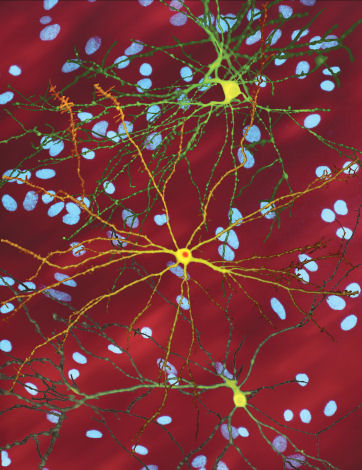
Researchers from Quebec Delay Symptoms of Huntington’s Disease in Mouse Model
 A montage of three images of single striatal neurons transfected with a disease-associated version of huntingtin, the protein that causes Huntington’s disease; By: Dr. Steven Finkbeiner, Gladstone Institute of Neurological Disease, The Taube-Koret Center for Huntington’s Disease Research, and the University of California San Francisco; licensed under the Creative Commons Attribution 3.0 Unported license.
A montage of three images of single striatal neurons transfected with a disease-associated version of huntingtin, the protein that causes Huntington’s disease; By: Dr. Steven Finkbeiner, Gladstone Institute of Neurological Disease, The Taube-Koret Center for Huntington’s Disease Research, and the University of California San Francisco; licensed under the Creative Commons Attribution 3.0 Unported license.
Patients with Huntington’s disease deteriorate physically, cognitively, and emotionally. There is no cure for the inherited illness, but scientists may have found a way to slow down the onset of symptoms. Researchers in Quebec increased the expression of a molecule known as pre-enkephalin (pENK) in a mouse model of Huntington’s disease (HD) and saw promising results.
Since reduced expression of pENK is a hallmark of the disease, and neurons containing this molecule are some of the first cells to die in the brains of HD patients, the researchers hypothesized that an HD brain over-expressing pENK might have beneficial results. Their study offers the first evidence that increased pENK expression leads to a delay in muscle dysfunction, improved motor activity, memory, and lower anxiety in early-onset HD.
To upregulate pENK, the researchers injected a viral vector carrying the molecule into the striatum of five-week old mice. Behavior tests conducted before and after the injection measured benchmarks of degeneration in the mouse model, including grip strength, clasping, open field movement, anxiety, memory and learning, and novel object recognition. At ten-weeks-old, HD mice over-expressing pENK performed better on many tests compared with controls (HD mice that did not receive pENK treatment). In other words, symptoms like motor dysfunction, which were assessed with the “grip strength” and “clasping” tests, appeared at six-weeks in the untreated HD mice, but didn’t show up until eight or ten weeks in mice over-expressing pENK.
Striatal neurons also benefited from pENK overexpression. Using the Optical Fractionator probe with Stereo Investigator to perform a stereological study of the region, the researchers saw more striatal neurons in 10-week-old pENK-treated HD mice compared to controls.
“The results of this study might open new horizon to investigate the cellular and molecular mechanisms by which enkephalin modulates motor response and signaling in HD, and may also contribute to the development of new therapeutical strategies and the gain in the quality of life in HD patients,” the authors say in their paper.
Bissonnette, S., Vaillancourt, M., Hébert, S. S., Drolet, G., & Samadi, P. (2013). Striatal Pre-Enkephalin Overexpression Improves Huntington’s Disease Symptoms in the R6/2 Mouse Model of Huntington’s Disease. Plos one, 8(9), e75099. http://www.ncbi.nlm.nih.gov/pmc/articles/PMC3770591/


